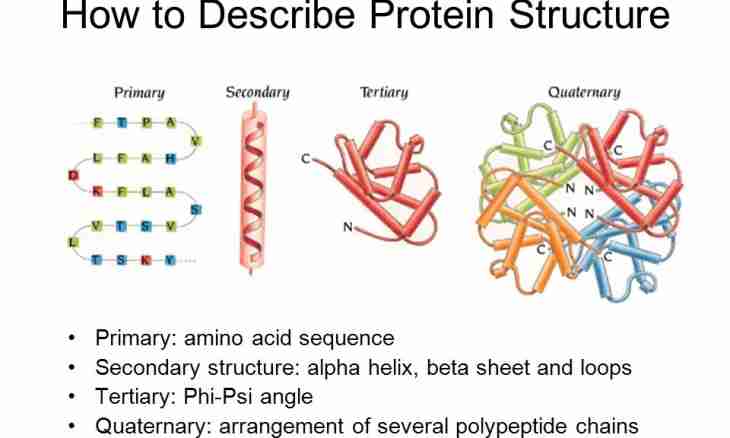Proteins are construction material of an organism. They are a part of blood, cages, internals and an epithelium. The person receives proteins as directly from food, and by synthesis by their organism, in particular, from other proteins.
Instruction
1. Proteins represent the organic compounds relating to biopolymers. At molecules of proteins there is a nitrogen, also they contain carbon, oxygen, hydrogen, sulfur, phosphorus and other chemical elements. These molecules are difficult and have considerable length. Proteins can be subdivided into two groups: proteins (simple proteins) and proteida (complex proteins). As a rule, proteins consist only of amino acids, and proteida include, besides them, and other substances. Also all proteins divide into fibrillar and globular proteins. Fibrillar proteins are badly soluble in water, their molecules have the extended form. They are a part of hair and an epithelium of the person. Hemoglobin belongs to group of globular proteins. Its molecules are curtailed into spherical chains. Insulin and pepsin belong to the same group.
2. Molecules of proteid are especially difficult on the building. The structure of these proteins can change at impact on them of external factors. In particular, treat them: effect of strong acids and ethyl alcohol, heating, pressure, ionizing radiation. Change of structure of protein call it a denaturation. In molecules of proteins there is amido group which is called peptide communication. This communication connects among themselves α-amino acids of proteins.
3. α-amino acids are considered as a basis of all albumens. Proteins turn out from residues of amino acids, and amino acids have two groups: COOH and NH2. Therefore in molecules of proteins there is amido group - C(O)-NH-. Depending on amount of amino acids the squirrels received various names. From two amino acids dipeptides, are formed of three - tripeptides, and of bigger quantity - polypeptides. Dipeptide, reacting with the third amino acid, gives tripeptide. In the drawing are represented molecules main, often meeting in life and the nature, tripeptides are shown. The structure of a proteinaceous molecule depends on amount of the amino acids which formed a peptide or polypeptide chain. Also the structure of protein as it is already told above, can change under the influence of external factors. Proteins can include over 20 amino acids. Thanks to the complex structure they participate practically in all processes of a metabolism. Hormones and antibiotics also concern to proteins. Especially important role in human life is played by the proteins received from food.

